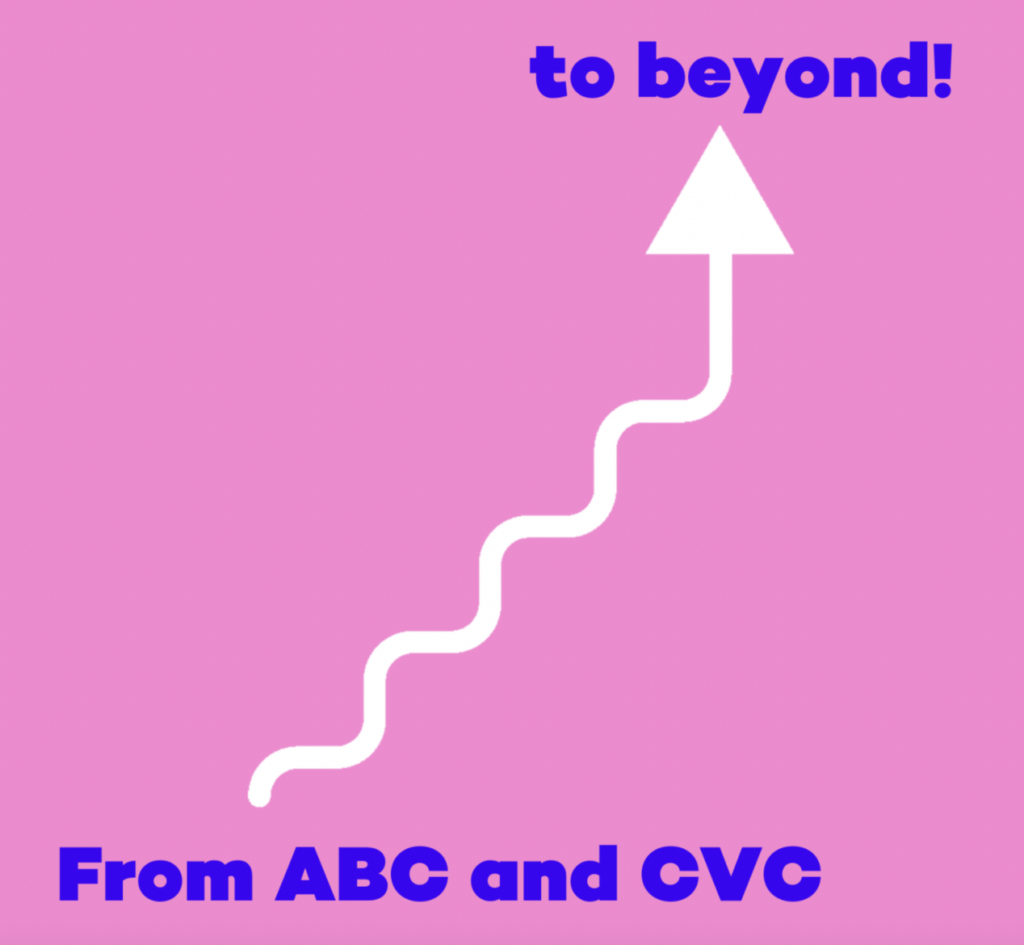
Current research shows that students learn how to read most effectively when the skills needed are taught explicitly and systematically. But understanding the exact order in which students should learn phonics rules and concepts can be daunting. Yes, there are numerous curricular programs you can follow that provide their own scope and sequence of skills, but teaching these skills means very little if you don’t know how each step relates to the one before and the one after. Here is a general roadmap of the order in which most students learn these concepts.
1. Phonological and Phonemic Awareness
This is the foundation upon which all phonics knowledge rests: the idea that sounds have meaning, symbols have meaning, and those sounds and symbols are actually intimately related! It is crucial that students have this foundational knowledge before they can even begin to learn how to read.
2. The alphabet
Unless you’ve taught preschool or Kindergarten, it’s easy to forget that children actually need to learn the alphabet! It’s not something we are born knowing, and it’s not as easy as one might think to teach it. But students don’t have to drill flashcards every night before they can begin putting words together. Even if a student knows just a few letters and their corresponding sounds, they can and should begin practicing putting those letters and sounds together.
3. Vowels vs. consonants
These are important distinctions for students to start making early. As they’re learning their letter names and sounds, they should also know whether the letter is a vowel or a consonant.
4. CVC words
These are the first types of words students will learn how to read. CVC stands for consonant-vowel-consonant. True CVC words have consonants that are pronounced the way they typically would be, and vowels that make a short vowel sound, like in the words bat, cup, and sip. (Be careful to make sure that the CVC words you present are true CVC words. For example, the ‘a’ in the word ‘was’ does not make a typical short ‘a’ sound. This is why it is common, especially at first, for students to misspell the word ‘was’ as ‘wuz.’)
5. Double final consonants
There are four letters that almost always get doubled at the end of a single-syllable, single-vowel word: s, f, l, and z. Examples are hiss, mass, fluff, staff, doll, hill, jazz, and buzz.
6. Consonant Digraphs
Students should now be ready to learn when two letters make one sound. Later, they’ll learn about vowel digraphs, but first, we’ll introduce them to consonant digraphs sh, ch, ck, th, and wh.
7. CCVC and CVCC words (aka consonant blends)
Once students have CVC words, digraphs, and double consonants somewhat solidly under their belts, they can begin practicing blending consonants together. This is what we do when we read words like “snap” and “band.”
8. Glued sounds
Otherwise known as “welded sounds,” these are ‘ng’ and ‘nk’ endings. Students usually learn these best when attached to vowels. Learning the ‘ong’ ending and reading/using it in a variety of contexts is more concrete for students than needing to blend the ‘ng’ ending onto any word they come across that has it. Glued sounds are ong, ing, ang, ung, onk, ink, ank, and unk.
9. Suffixes – Part I
Once students are introduced to some simple suffixes, the words they are able to read increase exponentially. Up until this point, a student may be able to read words like ‘sled’ and ‘sing,’ but when they are faced with the words ‘sledding’ or ‘singer,’ suddenly they are stuck. By teaching them simple suffixes, students are able to make sense of these new forms of words.
10. Long vowel sounds
Here’s where students can begin learning vowel digraphs like ‘ea’ and ‘oa.’ A popular rhyme to teach kids is “when two vowels go walking, the first one does the talking,” which is thought to help students remember that in a vowel team, the first letter is always the one that is pronounced, which is not always true! This rule applies to words like “meat”and “train,” but not to words like “sound” and “sleuth,” so use this rhyme with caution.
11. R-controlled vowels
Most students who learn about r-controlled vowels call them ‘bossy R words.’ That’s because when these vowels appear before an ‘r,’ the r changes the way we pronounce them. So instead of the typical short a sound in the word ‘stack,’ the ‘a’ sound changes in the word ‘star.’ That’s because of the bossy r. Students need a lot of time and practice with this skill. Unfortunately, there aren’t any clear-cut rules we can teach them about the differences between ur, er, and ir. They just need to be memorized.
12. Suffixes – Part II
Now you can begin introducing students to even more suffixes and their meanings. While it’s important to define each suffix for students, it’s much more important to give examples of words with these suffixes, showing the root word, whether it changes, what the word means, and how to use it. The more suffixes your students know, the more words they’ll be able to read!
13. Syllable types
There are six main syllable types: open, closed, silent e, r-controlled, vowel team, and consonant-le.
14. Miscellaneous
There are so many miscellaneous rules/concepts that just aren’t big enough for their own step! Some of the main ones are below:
-Hard/soft c & g (these letters are hard, as in cat and goat, unless followed by i, e, or y, as in city and giraffe)
-Silent letters (listen, ghost, climb, knee, half, guitar, write, column)
-ph = f
-age (as in cabbage and baggage)
-ture (as in picture and capture)
-W-influenced words, where w changes the pronunciation of the vowel after it (water, world, warm)
Getting through this sequence is a huge accomplishment! But it doesn’t mean that your kids are suddenly fluent readers. It can take years of reinforcing all of these concepts before a student becomes a fluent reader. These skills take time and a lot of practice. So be patient. And remember, this sequence is merely a guideline. Tune in to what your students need in order to most effectively help them become confident, competent, and successful readers. And always remind them that just as in life, there are exceptions to (almost) every rule!




